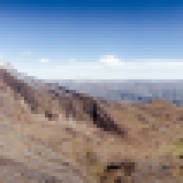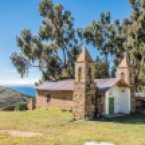May 13 – 16 Sorata
3 hours of a rather uncomfortable (if you are taller than 150 cm) microbus ride from La Paz, there is Bolivia’s trekking capital, Sorata. Situated at the feet of majestic Illampu, it is quite a sight. The village itself is quite small and uninteresting, mostly hotels and restaurants, but the surroundings are breathtaking, lush forests and green meadows contrast with snowy peaks of Illampu and Ancohuma massif.

If you are interested in trekking, I would recommend taking a guide. Not because the treks are difficult, but because more I travel, more I believe that westerners have a moral obligation to spend money sensibly in the third world countries. And buying services is sensible. It means a lot of money for them, more often than not it represents a difference for them, and for us it means not only just a tiny expenditure, but also a chance to talk to locals and to understand the reality of the place. There is a guide association office in the central square in Sorata, ran by a guy called Felix. If you are new in town, don’t worry, Felix will find you and explain everything. Felix found me while I was having a dinner in one of the restaurants. The night after Felix miraculously materialized in my hotel just as a couple of Kiwis were checking in. He means business, and he will do his best to get yours.

Hikes of various lengths and difficulties are available: Illampu circuit or Transcordillera (between 10 and 16 days, all food and camping equipment is carried by mules), you can camp overnight at Laguna Chillata, or you can do several day treks. As much as long treks are fun, I don’t really want to spend my next days with Felix and a donkey in the middle of nowhere in negative temperatures as soon as the sun goes down, so my choice is two separate day treks.
Day 1: Laguna Chillata: from 3500 to 4200 m. The ascend is surprisingly fast and not as difficult as I had imagined, and very rewarding: you reach the lagoon suddenly, you don’t see it and don’t know it’s there until you are standing right next to it, and then you find yourself overwhelmed by the reflection of Illampu in the lagoon’s surface. There are some Inca ruins nearby, although I don’t understand why would anyone feel the need to wall off a peak in 4000+ meters already accessible with extreme difficulty.
Day 2: Paso Abre Illampu, from 4000 into 4800 meters (and what would be the first day if I decided to trek the entire Illampu circuit). If the previous day seemed easy, this one does not, The thin air is really getting at me, the higher we go, the more effort each step takes. Well, step, I can barely drag one foot in front of the other, and I need to stop each twenty meters, force the air into my lungs, and bring my heartbeat to an acceptable rate. My guide, a man from the nearby village, really pisses me off, cause he walks as if he was on a sunday walk, doesn’t break a sweat, stops to chat with everyone we meet (I can barely gather enough breath to murmur buenos dias), walks in flip-flops, doesn’t carry a drop of water and when I offer him some (I carry 3 litres), he dismisses me with an condescending smile (as in: “I don’t need water to live, you silly earthling”). On one hand, I am glad I did not attempt to climb Huayana Potosi (over 6000 m), because a thousand meters lower is difficult enough, on the other I keep cursing under my (already weak) breath, trying to figure out why do I try each time to convince myself that I like hiking. Hours of suffering to reach this peak or the other for a few minutes of pleasure on top. This summary would fit pretty much most of my relationships, too. Only the pleasure last less.
May 16 – 22: Lake Titicaca
Last stop of my stay in South America: Copacabana. If you are a conservative person, you will travel from Sorata back to La Paz and change buses. If you are adventurous or simply cannot be bothered to spend three hours in the capital’s traffic, tell to the driver you want to go to Copacabana, he will drop you off in the village of Huarina, at the crossing of the two roads and you will catch your connection there. It will all work out, just don’t lose your spirit when the bus stops literally in the fields, dismisses you with a vague gesture of his hand (that means that the bus you need will go from across the road) and leaves. It’s all right. You will not wait for more than half an hour before something headed to Copacabana passes by.

Copacabana is a pleasant chilled town set on the shores of Lake Titicaca, there is an enormous colonial cathedral, nice promenade on the waterfront, and loads and loads of cafes (that do real coffee, not Nescafe or worse). Every bar blasts terrible pop music from the deepest abysses of the 90s, seems like they all play the entire collection of Bravo Hits (and if you don’t know what Bravo or Bravo Hits was, then your adolescence sucked almost as much as the soundtrack to mine). The altitude is killing me. I don’t have headaches, but I need to concentrate on breathing and every little hill leaves me breathless.
Bothering the locals:
There is not much to do in Copacabana except chill and eat trouts. Undoubtedly a welcome variation to the diet, however do not get too excited, all the fish is farmed, no one around here goes fishing, don’t be silly. Which is probably a good thing, given how excitable the locals are about pretty much everything, they would probably manage to trigger a Titicaca variation of Cod Wars over fishing rights and engage in a naval battle with Peru. There are several Inca ruins sites around the village, and if you really want to, you can climb the Calvario hill to watch the sunset, but you will have quite as nice view from the terrace of any cafe, and spare yourself the unnecessary Calvary. Other than that, there is Isla del Sol, according to the Incas, the birthplace of the sun.
Any of the agencies will take you to the island. Some of them advertise they organize visits to the northern part, too, do not believe them, it is a lie. Once it was possible to take a boat to the northern village, trek for three hours across the island, and come back from the southern harbour. It is no more. The northern community has been off-limits since last 9 months, no tourist can cross the checkpoint from the south and no boat can anchor in the northern harbour. The reason? The northern community was the richer one: they are closer to the Inca ruins (now inaccessible), they had more accommodation options and more restaurants with exquisite sunset views over the lake. The southern community wanted a slice of the pie, so they built a couple of hotels a bit too close to some archeological site, which is against bolivian law (which says no construction closer than 100 m, whatever the concept of law in this country may be). I believe local authorities disregarded the issue altogether, therefore one night the northerners decided to seek justice by their own means. They sneaked into the newly built hotels and blew them up with dynamite. Apparently, building 100 m from the ancient ruins: not OK; setting off explosives: acceptable. This incident understandably pissed off the other villagers, and they said: you know what, no more tourists for you. We block you off, try to live without the foreigners. This was 9 months ago, and to this day, if you want to approach the “border”, a nice young man will tell you kindly retreat. Solution to the dispute nowhere to be seen.
The birth of the sun at Isla del Sol:
Although the north has practically all the archeological sites (except for an unexciting Temple of the Sun), you can still stay in the south for a couple of days and just relax. Or not, if you come with the morning boat, you have plenty of time to see the half of the island, and depart in the afternoon. There is no need to book accommodation, literally every building is a hotel. I’d personally recommend not staying in the harbour, it’s picturesque and everything, but you will still have to climb the terrible stairs at some point, so best get it over with straightaway. Also, one good reason to spend the night on the Sun Island is dinner in Las Velas. It’s a little restaurant in the middle of the woods, no electricity, open only in the evening. The guy who runs it does everything on his own, from growing his vegetables to waiting the tables. There are 3 things on the menu: trout, steak, and a vegetarian pizza. Go for the trout, it’s delicious. If you need pizza, you are on a wrong continent (notice for Americans: pizza is italian. Italy is not part of New York). Turn up at sunset (18.00 ish), order your food, enjoy the view, and three hours and a few bottles of wine later, you will get your dinner. Our food came out around 9, but the restaurant has a lot of board games and cars, and when the sun goes down, the owner lights candles, so you will not be bored. You can play games in the dark with unknown strangers! Imagine the horror (for the English)!
Hummingbirds (and some non-humming birds, too):
My holiday enters the last stage on the evening of 22nd May. I am leaving Copacabana on the night bus to Cusco, from where I will embark on the long way home, via Mexico City (unfinished business) and Vancouver (a friend to visit). And then, I guess, a return to everyday sh….. grown-up life.








































What ?
LikeLiked by 1 person
What what?
LikeLiked by 1 person
“…why do I try each time to convince myself that I like hiking. Hours of suffering to reach this peak or the other for a few minutes of pleasure on top. This summary would fit pretty much most of my relationships, too. Only the pleasure last less.” Fantastic passage! (whose strength lies entirely on the ambiguity of its ending: hwich one lasts less?) 😀 😀
LikeLiked by 1 person